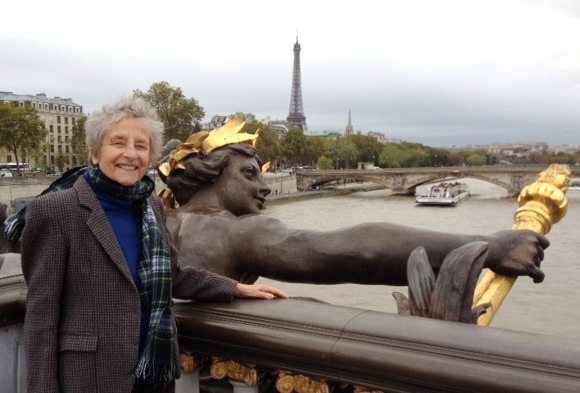
At the foot of Mount Mithridates, in eastern Crimea, stood the ancient city of Pantikapeion founded in the 7th century BC by Greek colonists. It is where King Mithridates killed himself in 63 BC by the sword since his body was immune to poison.
In 1992, I joined the archaeological expedition from the Pushkin Museum of Fine Arts led by Dr. V. Tolstikov, head of the department of near eastern antiquities, and Dr. Michael Treister, curator, in order to publish an article in Archaeology. That season the Russian team was researching the acropolis and a vast architectural complex with a colonnade dating from the 2nd century BC. Below the steep cliff, one could see modern Kerch and the Russian shore of the Krasnodar region across the five kilometer-wide Cimmerian Bosporus.
The scholars from the Pushkin museum were among the many Russian, Ukrainian and foreign archaeologists who have long been researching the rich strata of human occupation on the northern shore of the Black Sea. They have also studied the Scythian civilization, whose “kurgans” (tombs) contained the famous gold treasures.
The Institutes of Archaeology in the major cities, like Moscow, St Petersburg and Kiev, the universities and most of the museums, have their own expeditions. For instance, Odessa conducts regular excavations in Olbia, one of the major “emporia” (commercial trading post) for the export of cereals, fish and slaves to Greece and for import of Attic goods to Scythia. On the outskirts of Sebastopol, the ancient Greek city of Chersonesus has been excavated jointly by teams from Ukraine, the University of Texas and the German Institute of Archaeology.
Archaeologists, historians and other specialists exchange the results of their finds and publish joint papers in scholarly journals. The Center for Research on Ancient History, located in Besançon in eastern France, is an invaluable source for the Black Sea region and has collected works from scholars, irrespective of their nationality. Periodically, a Black Sea symposium, which attracts several hundred scientists, meets in Vani, Georgia.
After this long description of the archaeological scene in the Black Sea region, the question arises: what is going to happen to this fruitful scientific collaboration currently happening across the borders ?

During our sail along the Black Sea coast in 1991 (see the Feb. 8 Sochi article posted on this site), we saw dozens of wind turbines near Evpatoria in western Crimea. Today, Ukraine and Russia have ambitious plans to create a wind farm of 3,000 sq. km. for a grid power of 16,000 MW. Aeolian energy is readily available in this area, thanks to the shallow waters of the Black Sea and the Sea of Azov.
On March 20, Le Monde published an article entitled, “Antonov mirrors the break between Russia and Ukraine.” The article explains how the Ukrainian aircraft manufacturing and services company, Antonov, builds planes with technology and software from Dassault Systemes and employs 16,000 Ukrainian workers, but 40 percent of the parts utilized in production are Russian.
On March 22, a Moscow official announced that the extension of the capital’s subway had to be put on hold since they could not take delivery of some of the construction material ordered from the Ukraine.
In the art world, a Paris galerist told me they also were expecting difficulties in the near future.
Human, cultural and economic ties between Ukraine, Crimea and Russia are so interwoven that the break up of the Ukrainian territorial integrity and the announced sanctions from the West are bound to have serious consequences.
Vladimir Putin is supposed to be an excellent chess player. One assumed that each one of his moves was made according to a planned strategy. This does not seem to be true anymore. He has won the Crimea, but what about the long term waves he is making? Problems are going to catch up with him.
 About the author: Nicole Prévost Logan divides her time between Essex and Paris, spending summers in the former and winters in the latter. She will write a regular column for us from her Paris home where her topics will include politics, economy, social unrest — mostly in France — but also in other European countries. She also will cover a variety of art exhibits and the performing arts in Europe. Logan is the author of ‘Forever on the Road: A Franco-American Family’s Thirty Years in the Foreign Service,’ an autobiography of her life as the wife of an overseas diplomat, who lived in 10 foreign countries on three continents. Her experiences during her foreign service life included being in Lebanon when civil war erupted, excavating a medieval city in Moscow and spending a week under house arrest in Guinea.
About the author: Nicole Prévost Logan divides her time between Essex and Paris, spending summers in the former and winters in the latter. She will write a regular column for us from her Paris home where her topics will include politics, economy, social unrest — mostly in France — but also in other European countries. She also will cover a variety of art exhibits and the performing arts in Europe. Logan is the author of ‘Forever on the Road: A Franco-American Family’s Thirty Years in the Foreign Service,’ an autobiography of her life as the wife of an overseas diplomat, who lived in 10 foreign countries on three continents. Her experiences during her foreign service life included being in Lebanon when civil war erupted, excavating a medieval city in Moscow and spending a week under house arrest in Guinea.